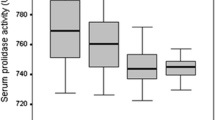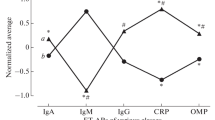Abstract
In this study, serum antioxidant and oxygen derived free radical status of patients with ankylosing spondylitis (AS) was investigated and compared with that of age- and sex-matched healthy controls. The relationship of these parameters to disease activity indices was also examined. Thirty patients with AS not currently under disease-modifying antirheumatic drug (DMARD) treatment (e.g., sulfasalazine or methotrexate) (15 active and 15 inactive) and 16 age- and sex-matched healthy controls were included in the study. Catalase (EC 1.11.1.6), total (Cu-Zn and Mn) superoxide dismutase (SOD) (EC 1.15.1.1) activities, and malondialdehyde (MDA), nitrite (NO2 -), and nitrate (NO3 -) levels as indices of nitric oxide (NO) production were evaluated using appropriate methods. There was no statistically significant difference found in SOD activity or NO and MDA levels between active and inactive patients. Inactive patients showed no significant difference in all the measured oxidant/antioxidant parameters when compared to healthy controls. Active patients had significantly higher levels of MDA and catalase enzyme activity (P=0.002 and P=0.007, respectively). There was no significant correlation between oxidant/antioxidant parameters and disease activity, C-reactive protein, erythrocyte sedimentation rate, or Bath Ankylosing Spondylitis Disease Activity Index (CRP, ESR, or BASDAI) in either group, except catalase enzyme activity, which had a significant correlation with CRP and ESR levels in active patients (r=0.69 and P=0.004, r=0.52 and P=0.04, respectively). Our results indicate that oxidative stress and lipid peroxidation are accelerated in untreated patients with active AS. Serum catalase activity may be closely related to disease activity. In this regard, we underscore the likely benefit of some therapeutic interventions including high-potential antioxidants that will potentiate the antioxidant defense mechanism and reduce peroxidation in the management of AS.

Similar content being viewed by others
References
Khan MA (1994) Ankylosing spondylitis: clinical features. In: Klippel J, Dieppe P (eds) Rheumatology. Mosby Year Book Europe, London, 3:25.1–3.25.10
Blake DR, Merry P, Unsworth J, Kidd BL, Outhwaite JM, Ballard R et al (1989) Hypoxic-reperfusion injury in the inflamed human joint. Lancet 1:289–293
Lunec J, Halloran SP, White AG, Dormandy TL (1981) Free-radical oxidation (peroxidation) products in serum and synovial fluid in rheumatoid arthritis. J Rheumatol 8:233–245
Imadaya A, Terasawa K, Tosa H, Okamoto M, Toriizuka K (1988) Erythrocyte antioxidant enzymes are reduced in patients with rheumatoid arthritis. J Rheumatol 15:1628–1631
Abella A, Clerc D, Chalas J, Baret A, Leluc R, Lindenbaum A (1987) Concentration en superoxyde dismutase (cuivre et manganèse), catalase et glutathion peroxydase dans les hématies, les plaquettes et le plasma de sujets atteints de polyarthrite rhumatoïde. Ann Biol Clin 45:152–155
Gambhir JK, Lali P, Jain AK (1997) Correlation between blood antioxidant levels and lipid peroxidation in rheumatoid arthritis. Clin Biochem 30:351–355
Floyd RA (1990) Role of oxygen free radicals in carcinogenesis and brain ischemia. FASEB J 4:2587–2597
8-Wendling D, Didier JM, Vuitton DA (1991) The phagocyte oxidative metabolism function in ankylosing spondylitis. Rheumatol Int 11:187–189
Biasi D, Carletto A, Caramaschi P, Bellavite P, Andrioli G, Caraffi M, et al (1995) Neutrophil functions, spondylarthropathies and HLA-B27: a study of 43 patients. Clin Exp Rheumatol 13:623–627
Ho KJ, Chen PQ, Chang CY, Lu FJ (2000) The oxidative metabolism of circulating phagocytes in ankylosing spondylitis: determination by whole blood chemiluminescence. Ann Rheum Dis 59:338–341
Van der Linden S, Valkenburg HA, Cats A (1984) Evaluation of diagnostic criteria for ankylosing spondylitis. A proposal for modification of the New York criteria. Arthritis Rheum 27:361–368
Calin A, Nakache JP, Gueguen A, Zeidler H, Mielants H, Daugados M (1999) Defining disease activity in ankylosing spondylitis: is a combination of variables (Bath Ankylosing Spondylitis Disease Activity Index) an appropriate instrument? Rheumatology 38:878–882
Aebi H (1974) Catalase. In: Bergmeyer HU (ed) Methods of enzymatic analysis. Academic Press, New York, pp 673–677
Sun Y, Oberley LW, Li Y (1988) A simple method for clinical assay of superoxide dismutase. Clin Chem 34:497–500
Wasowicz W, Neve J, Peretz A (1993) Optimized steps in fluorometric determination of thiobarbituric acid-reactive substances in serum: importance of extraction pH and influence of sample preservation and storage. Clin Chem 39:2522–2526
Cortas NK, Wakid NW (1990) Determination of inorganic nitrate in serum and urine by a kinetic cadmium-reduction method. Clin Chem 36:1440–1443
Clancy RM, Amin AR, Abramson SB (1998) The role of nitric oxide in inflammation and immunity. Arthritis Rheum 41:1141–1151
Stichtenoth DO, Frolich JC (1998) Nitric oxide and inflammatory joint diseases. Br J Rheumatol 37:246–257
Malinski T, Taha Z (1992) Nitric oxide release form a single cell measured in situ by a porphyrinic-based microsensor. Nature 358:676–678
Koltuksuz U, Irmak MK, Karaman A, Uz E, Var A, Ozyurt H et al (2000) Testicular nitric oxide levels after unilateral testicular torsion-detorsion in rats pretreated with caffeic acid phenethyl ester. Urol Res 28:360–363
Sahin S, Sogut S, Ozyurt H, Uz E, Ilhan A, Akyol O (2002) Tissue xanthine oxidase activity and nitric oxide levels after spinal cord ischemia/reperfusion injury in rabbits: comparison of caffeic acid phenethyl ester (CAPE) and methylprednisolone. Neurosci Res Commun 31:111–121
Stichtenoth DO, Wollenhaupt J, Andersone D, Zeidler H, Frolich JC (1995) Elevated serum nitrate concentrations in active spondylarthropathies. Br J Rheumatol 34:616–619
Pullar T, Zoma A, Capell HA, Khan MF, Brown DH, Smith WE (1987) Alteration of thiol and superoxide dismutase status in rheumatoid arthritis treated with sulfasalazine. Br J Rheumatol 26:202–206
Toth KM, Berger EM, Beehler CJ, Repine JE (1986) Erythrocytes from cigarette smokers contain more glutathione and catalase and protect endothelial cells from hydrogen peroxide better than do erythrocytes from nonsmokers. Am J Respir Dis 134:281–284
Akyol O, Isci N, Temel I, Ozgocmen S, Uz E, Murat M et al (2001) The relationships between plasma and erythrocyte antioxidant enzymes and lipid peroxidation in patients with rheumatoid arthritis. Joint Bone Spine 68:311–317
Author information
Authors and Affiliations
Corresponding author
Rights and permissions
About this article
Cite this article
Ozgocmen, S., Sogut, S., Ardicoglu, O. et al. Serum nitric oxide, catalase, superoxide dismutase, and malondialdehyde status in patients with ankylosing spondylitis. Rheumatol Int 24, 80–83 (2004). https://doi.org/10.1007/s00296-003-0335-y
Received:
Accepted:
Published:
Issue Date:
DOI: https://doi.org/10.1007/s00296-003-0335-y




